I found these illustrations and descriptions in an old art magazine of the period and thought that they may be of interest to members.
The Paris Universal Exhibitions followed the success of the great London Exhibition of 1851 which attracted over six million people to Hyde Park. France followed with exhibitions in 1855, 1867 and 1878 all with great success.
The French had started having national exhibitions as early as 1798 and held them every five years or so, but it was Britain’s great ‘Exhibition of the Works of all Nations’ that really set the standard for the future ‘World’s Fairs’.
The 1878 ‘Exposition Universelle’ attracted some thirteen million people through its doors to see such demonstrations as Alexander Graham Bell’s telephone and Thomas Edison’s electric light bulbs and phonograph, they might be handy, I suppose… but lets proceed to the really interesting displays.
‘In the work of the jeweller and the goldsmith the French have made a splendid display--- and one which defeats all comparison with that of any other country taking part in the Exhibition. The system of collective exhibitions, which has been followed without exception by all the different classes of French exhibitors, is admirably adapted for those classes of goods wherein the objects are relatively small in them-selves, and rely much for their effect upon the skill with which they are set out and displayed before the spectator. French jewellers are exceedingly clever in arranging their exhibits in the most attractive way, and the Jewellery and Silver Courts are worthy of study. The black show-cases, with rich velvet linings, and the beautiful gems they contain, are seen to the greatest advantage. It is almost impossible, by means of any illustration, to convey to our readers the richness and charm of the splendid jewels to be seen in the Exhibition.’
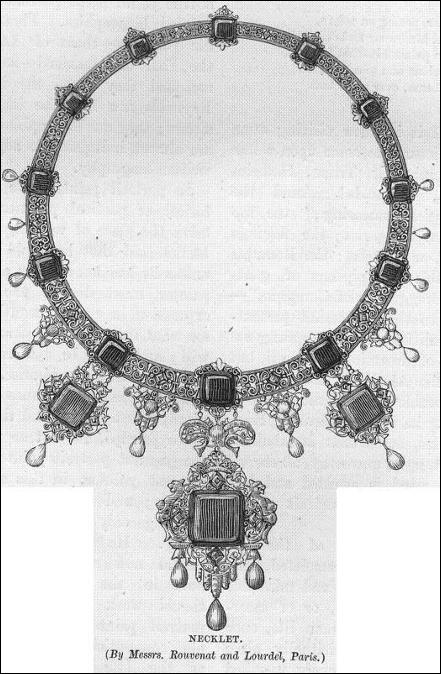
‘We have engraved a necklace, by Messrs. Rouvenat and Lourdel, of Paris. This firm contributes many elegant and graceful objects, and the necklet we illustrate is partly of silver and partly of gold, and is set with rose diamonds, emeralds, and cameos, the pendants being very fine pearls, and the principal pendant set with brilliants and emeralds, and surmounted by a crown set with brilliants. The setting is Italian in design, and is admirable in the taste of the mounts and in the choice of jewels. The same firm shows a beautiful little statuette, designed by Carier Belleuse, in mixed metals and enamel. We have selected this figure for an engraving as an excellent specimen of this class of work’.
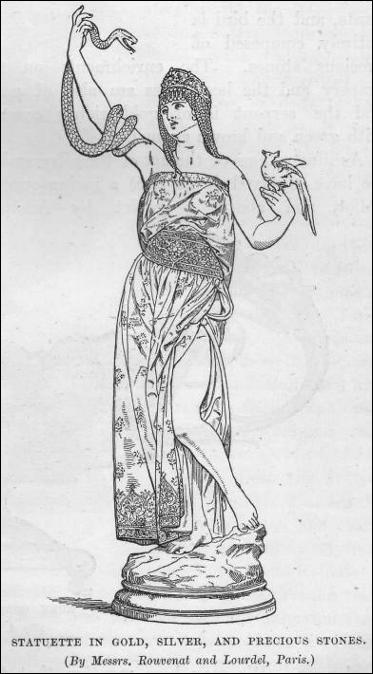
‘The combination of the art of the goldsmith and of the bronzist has been carried out in this statuette to the extent of the insertion of real jewels for the ornaments, which is done with very good effect; thus, while the figure is of bronze, the drapery is of silver, looped up with turquoise; the flowers of gold, set with brilliants, and the bird is entirely composed of precious stones. The enrichments on the drapery and the head-dress are also of gold, and the serpent is of gold , richly covered with green and brown enamel.
As illustrations of the art of the silversmith, we have engraved a racing-cup by Odiot, and a goblet by Adolphe Boulenger. We may here mention that the firms just referred to are two of the most eminent in Paris.’
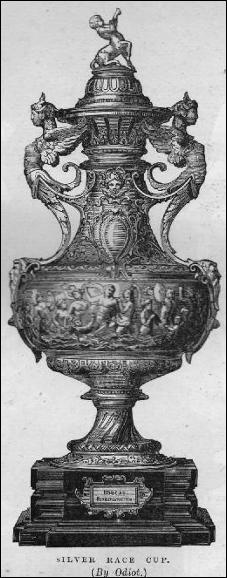
‘The racing-cup was won by “Nougat” at the Paris races in April 1876. It is of silver, on a base of black marble, and is a most successful example of the decoration of silver by varied treatments of the surface. The design, which partakes of the character of the best work of the Renaissance, has been partly executed by chasing and partly by repousse work--- the mouldings are everywhere burnished, all the principal surfaces being very effectively frosted.’
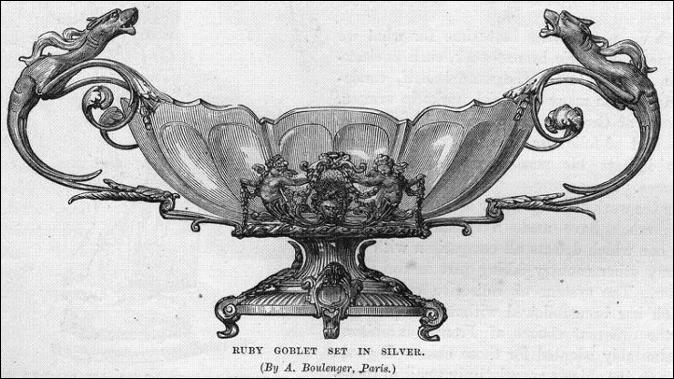
‘The goblet by Boulenger consists of a ruby-glass cup, cut into bold facets, and mounted in silver, with silver-gilt handles and base---the surfaces of the gold being frosted. The actual processes of manufacture in a great many branches of goldsmiths' work and jewellery are to be seen in operation in the extremely interesting and instructive “Galerie du Travail” at the end of the Exhibition building nearest the Military School.
Much excellent workmanship is expended in the production of false or imitation jewellery; indeed, personal ornaments and trinkets of this kind must be extensively made in France, to judge by the many vendors who announce the nature of their goods, as they are, we believe, by law compelled to do, by the single word “imitation”. There is much more taste in this kind of jewellery, as we see it in all its splendour in the Exhibition, or under even better conditions in the Palais Royal, than is to be found in our own cheap trinkets, which seem seldom to avoid coarseness and vulgarity. Much of the French imitation jewellery can scarcely, except by the expert, be detected from the real, and the best skill and the most artistic design is displayed upon the setting of the pastes and crystals which take the place of real stones.’
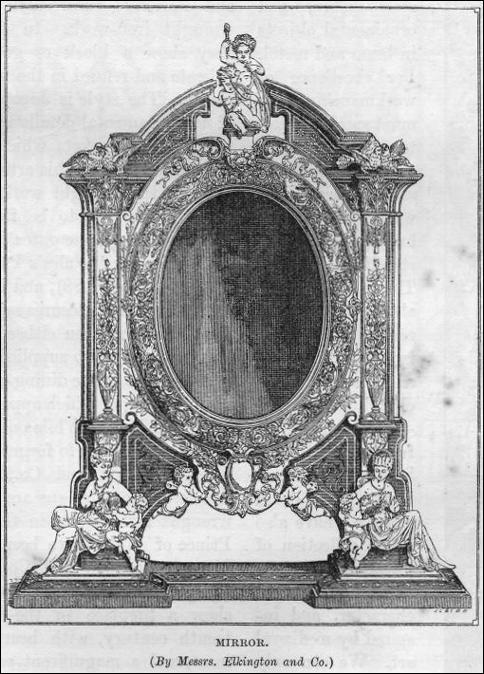
'Messrs. Elkington and Co. have a most splendid show of repousse works, damascened work in various metals, silver castings chased and electro-gilt. We have selected for illustration a fine mirror in silver repousse work. Their electro-deposited reproductions of famous art treasures and ancient metal-work have attained a world-wide fame, and they have made marked progress in their cloisonné and champ-leve enamel-work'.
Trev.
.
